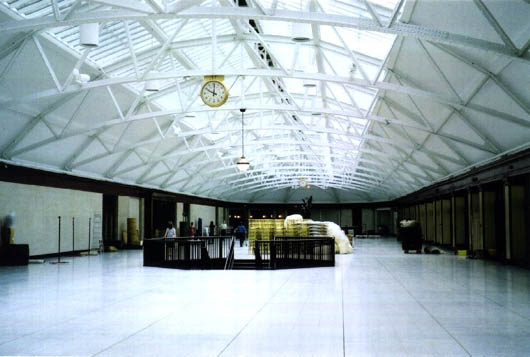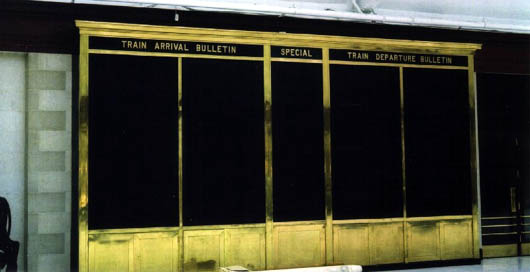
5 June 2007
The Storied Windsor Station Has Seen its Share of Joy and Despair

Montreal Quebec - Virtually every day, as part of my
well-established morning routine, I pass through the main concourse of Montreal's majestic and historic Windsor Station.
More often than not when I do so, this now-disused station (a jewel of Victorian urban architecture), is devoid of human
beings and all mortal activity. Occasionally, but just occasionally, when the grand hall has been leased for an evening gala, workmen
will be found configuring the space for that specific happening. This, however, is the exception and not the rule.
Normally, whenever I enter this august expanse from Montreal's golden past, my pace slows and I meander about the celebrated complex
deep in reflection.

I always stop for a few moments in front of the venerable brass-framed departure-and-arrival board, which now
displays eight large, poignant photos from bygone times of the illustrious edifice. My preferred depiction is the one from the Second
World War where the concourse is replete with soldiers and sailors, all most likely about to go off to conflict. I eagerly scrutinize
the image, looking intently at the diverse faces present in the black-and-white representation. Many, aware that the
picture was about to be taken, peer resolutely back at me, and into history.
My initial (albeit vague) memory of this striking railway station goes back to my early childhood when my mother took my sister and me
to the passenger depot to greet my father who was returning, via New York, from a two-month business trip to England. The
vessel upon which he had sailed the Atlantic was none other than the Cunard Liner Queen Elizabeth. He made his way from New York, by
overnight train, to Windsor Station where the three of us were anxiously awaiting his return. My sister, then 8, remembers our parents'
long embrace.
For my part, a child of 6 at the time, I don't recall much of what I imagine was a distinctly happy family event. Little could I have
realized that some 14 years later that same grey limestone-clad rail terminus would, for a brief period of time, become
pivotal to my own life.
It was during the summer of 1967, some 40 years ago. I was engaged as a "garçon de table" on Canadian Pacific's
transcontinental run, the origin of which was that same iconic Windsor Station. What better way, I thought, for a poor struggling
university student to celebrate Canada's Centennial than exploring the country while, at the same time, earning ready money.
I reported to the station once a week, to a rather drab-looking office just beyond the security buffers found at the end
of each track. Once there, I met up with the other members of my standing crew; we all signed in, then climbed aboard our quaint and
dated dining car wagon for its 8 P.M. departure, bound for Western Canada. Lucklessly (as we then thought), our part of the run ended
in Winnipeg and, consequently, none of us ever got to see the Rockies and, beyond them, Vancouver, about which we had all dreamt.
As far as the renowned Montreal train terminal was concerned, at 20, I was completely oblivious to it and the significance of its
history to this city. Indeed, the limitations of advanced adolescence are such that I did not even once recall that joyful family
morning in June of 1953, and, without doubt, I was totally unaware of the incredible tragedy that had unfolded in that very same
station some 58 years earlier.
On St. Patrick's Day of 1909, several lives were lost when an out-of-control express passenger train from Boston blasted
its way through, first the buffers, then the ladies' waiting room, before finally coming to rest on the main concourse of the station
itself, killing or injuring all those who were in its way. Both the fireman and the engineer had jumped from the ill-fated
locomotive before it careered wildly into the terminal early that morning. Mr. W. J. Nixon of Ash Street, Montreal, lost his wife and
both children - all three meeting death while waiting for him in the Ladies' Waiting Room, a portion of which was levelled by the force
of the violent impact.
Intriguingly, in a strange twist of fate, a third child, one Elsie Villiers, a survivor of the infamous 1907 Hochelaga School fire
which cost the lives of 16 pupils and their teacher Sarah Maxwell, was killed instantly when debris fell upon her as a result of that
tragic mishap.
Footprints? When I next find myself standing well-nigh alone in the "salle des pas perdus" of beautiful Windsor
Station, I will muse on the invisible footprints that have been left behind by all who have passed within its historic
fortress-like walls.
|